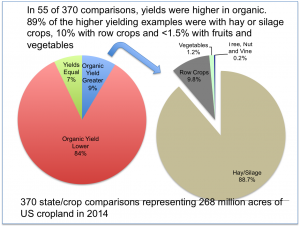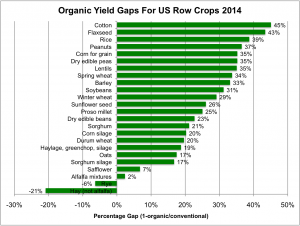The Lower Productivity Of Organic Farming: A New Analysis And Its Big Implications
有机农业生产率更低:一项新的分析及其重大含义
作者:Steven Savage @ 2015-10-9
译者:沈沉(@你在何地-sxy)
校对:babyface_claire
来源:Forbes,http://www.forbes.com/sites/stevensavage/2015/10/09/the-organic-farming-yield-gap/
The productivity of organic farming is typically lower than that of comparable “conventional” farms. This difference is sometimes debated, but a recent USDA survey of organic agriculture demonstrates that commercial organic in the U.S. has a significant yield gap.
有机农业的生产率通常低于可比的“传统”农业。其中差异时有争论,不过美国农业部最近关于有机农业的一项调查证实,美国的商业有机作物存在一个巨大的产量差距。
I compared 2014 survey data from organic growers with overall agricultural yield statistics for that year on a crop by crop, state by state basis. The picture that emerges is clear – organic yields are mostly lower. To have raised all U.S. crops as organic in 2014 would have required farming of one hundred nine million more acres of land. That is an area equivalent to all the parkland and wildland areas in the lower 48 states or 1.8 times as much as all the urban land in the nation.
我将采自有机作物种植者的2014年调查数据与农业总产量统计数据分作物、分州别进行了对比,得出的画面非常清晰——有机作物的产量一般都更低。如果2014年全美农作物都是有机种植,那么需要耕种的土地将比实际多出1.09亿英亩。这一面积相当于本土48州所有绿地和荒地的总和,或全国所有城市用地之和的1.8倍。
As of 2014 the reported acreage of organic cropland only represented 0.44% of the total, but if organic were to expand significantly, its lower land-use-efficiency would become problematic. This is one of several reasons to question the assertion that organic farming is better for the environment.
到2014年,公开的有机农用地面积只占全部农地的0.44%,但如果有机种植大幅扩张,它那较低的用地效率将很棘手。有人断言有机农业对环境更有利,这里提到的只是质疑理由之一。
The USDA conducted a detailed survey of organics in 2008 and then again in 2014. Information is collected about the number of farms, the acres of crops harvested, the production from those acres, and the value of what is sold. The USDA also collects similar data every year for agriculture in general and makes it very accessible via Quick Stats.
美国农业部2008年对有机作物进行了一次详细调查,2014年又做了一次。采集的信息包括农场数量、作物收获面积、产量和卖出总价。美国农业部每年还针对全部农业采集类似数据,并在Quick Stats上公开发布。
It is interesting that they don’t publish any comparisons of these two data sets as they would be able to make comparisons on a county basis. By working with both USDA data resources I was able to find 370 good comparisons of organic and total data for the same crop in the same state and where the organic represented at least 20 acres. That comparison set covers 80% of US crop acreage.
有意思的是,尽管他们对这两组数据能够做到分县对比,他们却从不发布任何比较结果。通过使用这两份来自美国农业部的数据,我得以找出370组有机数据和总数据之间的高质量比较,每组比较的均是有机作物种植面积20英亩以上的同一个州的同一种作物。这一比较涉及了美国农作物种植面积的80%。
【2014年有机与传统农业统计数据比较概要】
For 292 of those comparisons, the organic yields were lower (84% on an area basis). There were 55 comparisons where organic yield was higher, but 89% of the higher yielding organic examples involved hay and silage crops rather than food crops. The organic yield gap is predominant for row crops, fruit crops and vegetables as can be seen in the graphs below.
在其中292个比较结果中,有机作物产量都要更低(以面积而言占到84%)。有机作物产量更高的,有55组比较结果。但这些产量更高的案例中有89%种的是干草和青贮饲料作物,而非食用作物。以下图表显示:有机作物产量差距在中耕作物、水果作物和蔬菜中非常突出。
The reasons for the gap vary with crop and geography. In some cases the issue is the ability to meet periods of peak nutrient demand using only organic sources. The issue can be competition from weeds because herbicides are generally lacking for organic. In some cases its reflects higher yield loss to diseases and insects. Although organic farmers definitely use pesticides, the restriction to natural options can leave crops vulnerable to damage.
出现差距的原因随作物和地理不同而有所不同。在某些情形中,问题出在只用有机资源来满足营养需求高峰的能力上。问题也可能出在杂草竞争,因为有机作物中一般不用除草剂。在某些情形中,它反映的是因病害和虫害导致的减产。尽管种植有机作物的农场主绝对也会用杀虫剂,但是对天然产品的限制要求仍会让作物更易受到伤害。
I’ve posted a much more detailed summary of this information on SCRIBD with the data at the state level.
有关上述信息,我已在SCRIBD上贴了一份更加详细的摘要,用的是州级层面的数据。
【大量主要中耕作物采用有机种植时产量大幅降低】
【有机水果和坚果的产量绝大多数都大幅低于传统种植】
【蔬菜作物中的产量差距存在巨大差异】
There is some potential for artifacts within this data set. If the proportion of irrigated and non-irrigated land differs between organic and conventional that would skew the data. With lettuce and spinach it is likely that the organic is proportionally more in the “baby” category making yields appear dramatically lower.
这组数据中可能存在一些人为现象。如果在有机种植和传统种植中,灌溉地和非灌溉地的比例不同,那么数据就有所扭曲。生菜和菠菜的有机种植可能很大程度上仍属于“婴儿”类,故而产出差距看起来十分大。
But overall this window on farming is useful for understanding the current state of commercial organic production. Since the supply of prime farmland is finite, and water is in short supply in places like California, resource-use-efficiency is an issue even at the current scale of organic (1.5 million cropland acres, 3.6 million including pasture and rangeland).
但总体来说,这一农业信息窗口很有用,能让我们了解商业有机作物生产的现状。由于优质农田的供给是有限的,而在加州等地,水也存在供给短缺,因此,即便是以有机作物当前的种植面积(150万英亩耕地,包括草地和牧场则为360万亩)来说,资源利用效率也是个大问题。
You are welcome to comment here and/or to email me at [email protected]. I’d be happy to share a data file with interested parties and to get feedback about where particular yield comparisons might be misleading. A more detailed presentation is available at https://www.scribd.com/doc/283996769/The-Yield-Gap-For-Organic-Farming
欢迎提出评论或发送邮件至[email protected]。我愿意和感兴趣者分享数据文件,如果哪个具体的产量比较可能具有误导性,我也希望得到反馈。更详细的介绍请见:https://www.scribd.com/doc/283996769/The-Yield-Gap-For-Organic-Farming
(编辑:辉格@whigzhou)
*注:本译文未经原作者授权,本站对原文不持有也不主张任何权利,如果你恰好对原文拥有权益并希望我们移除相关内容,请私信联系,我们会立即作出响应。
——海德沙龙·翻译组,致力于将英文世界的好文章搬进中文世界——

 订阅
订阅



暂无评论
发表评论